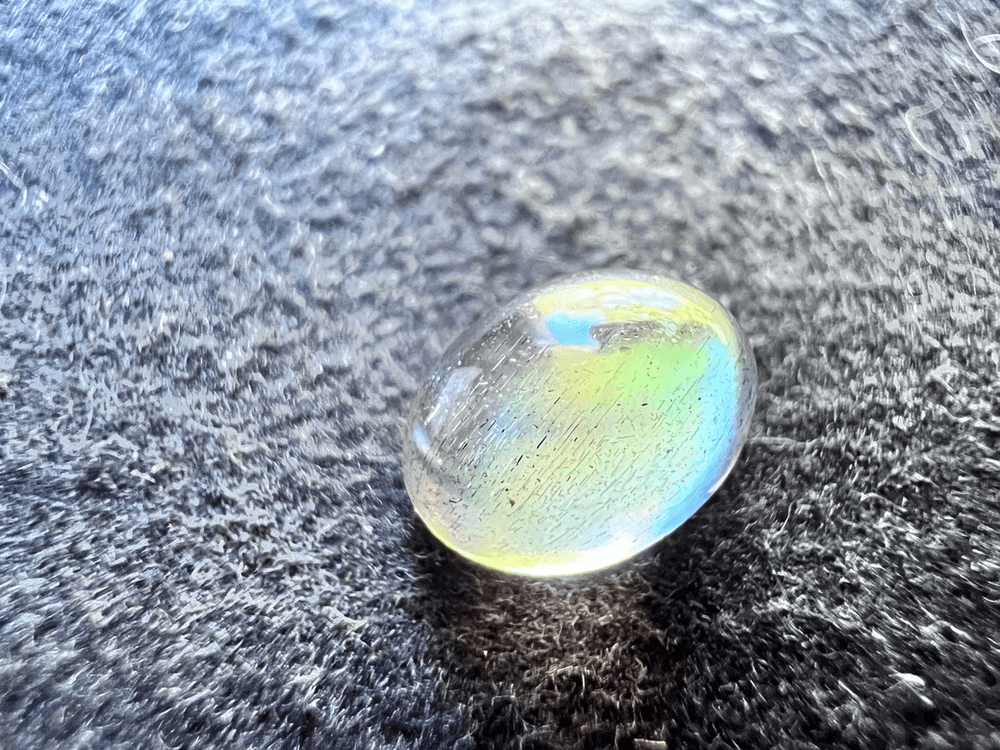Labradorite: Properties, Uses and Virtues
Labradorite: The short version for people in a hurry!
Labradorite, a variety of Feldspar, forms in silica-rich magmatic rocks, giving rise to shimmering, multi-hued flakes. It is present in various parts of the world, including Labrador in Canada.
Renowned for its metaphysical properties, it promotes energetic protection and spiritual balance. Its hardness of 6 to 6.5 on the Mohs scale makes it robust but prone to fracture. Labradorite treatments are poorly documented, but oiled labradorite can be found.
Common imitations include plastic and resin, but the natural texture of stone is recognizable to the naked eye. To care for Labradorite, clean with lukewarm water and a soft cloth, avoiding harsh chemicals and direct exposure to sunlight.

Labradorite: Properties, Uses and Virtues in Detail
Labradorite: Table of contents
- Labradorite: The short version for people in a hurry!
- Geological formation of Labradorite
- Raw Labradorite – Natural Radiance Revealed
- Sources – Labradorite World Presence
- Historical Significance of Labradorite – A Mystical Heritage
- Metaphysical properties of Labradorite – Energy of Serenity
- Labradorite varieties
- Labradorite color
- Durability and portability of Labradorite
- Labradorite Enhancements – Preserving its Natural Splendor
- Synthetic Labradorite – Natural Laboratory Inspiration
- Labradorite Imitations – Distinguishing the Genuine
- Labradorite care – Preserving its natural beauty
Geological formation of Labradorite
Labradorite is a fascinating gem from the feldspar family, formed under very specific geological conditions. Originating from silica-rich magmatic rocks, it emerges under the influence of slow, complex cooling processes. These special geological conditions give rise to shimmering sparkles and shades of blue, green, yellow and red.
Raw Labradorite – Natural Radiance Revealed
rough Labradorite crystals are generally irregular in shape, with textured surfaces and varied contours. It is rare but possible to find formed crystals. These rough samples often reveal rough facets with striations on the surfaces.
Sources – Labradorite World Presence
Labradorite is found in every corner of the globe: Scandinavia, Canada (especially Labrador, from which it takes its name), Russia, Australia, the United States… Each region has its own unique character. Finnish labradorites are often called spectrolites for their vivid colors and marked labradorescence.
Historical Significance of Labradorite – A Mystical Heritage
First officially described by Adolarius Forster in 1780, labradorite owes its name to the Labrador region of Canada.
I haven’t found much factual data for the history of labradorite, only rumors without any source and often perpetrated by salesmen and litho-therapists.
However, it is likely, given its locality, that labradorite was indeed discovered and used by the Inuit of the Labrador regions.
Metaphysical properties of Labradorite – Energy of Serenity
Labradorite is renowned for its metaphysical properties that encourage energetic protection, spiritual balance and personal growth. It is said to act as a shield against negative energies, helping to dispel emotional blockages and promote mental clarity.
Labradorite varieties
Spectrolite can be considered a variety of labradorite.
Labradorite color
The base color can be tinted brown or yellow, but can also be colorless, dark blue or gray. Labradorite often displays adularescence (or labradorescence) effects that create almost metallic reflections of blue, green, yellow or red.
There is a transparent variety with an effect similar to that of moonstone, but distinguished from it by the presence of yellow or red.
Durability and portability of Labradorite
Robust yet delicate, labradorite has a hardness of 6 to 6.5 on the Mohs scale and a perfect cleavage, making it prone to fracture. As with most feldspars, labradorite should be worn in protected jewelry and care should be taken with other stones.
Labradorite Enhancements – Preserving its Natural Splendor
Treatments of labradorite are poorly documented, which suggests that it is often left in its original state. It is common to appreciate this stone with its inclusions and fractures rather than hiding them. However, oiled labradorite is likely to be found.
Synthetic Labradorite – Natural Laboratory Inspiration
Synthetic labradorites are not commercially available and have been synthesized for scientific purposes. It is far more likely to find imitation labradorite.
Labradorite Imitations – Distinguishing the Genuine
Among the culprits: resins and plastics. As explained in the opal jewelry guide, be sure to observe the light entering the stone and reflecting off the different layers. Labradorite’s natural texture is easily visible to the naked eye.
Labradorite care – Preserving its natural beauty
A little lukewarm water and a soft cloth are all you need to keep your labradorite sparkling, avoiding harsh chemicals and abrasive cleaners. Just avoid direct sunlight and harsh chemicals to keep its dazzling shine.
Most labradorites can be porous due to their many micro-fractures and inclusions. Be sure to limit the use of perfumes, oils and creams when wearing the stone, or simply apply them beforehand.





Leave a Reply
Want to join the discussion?Feel free to contribute!